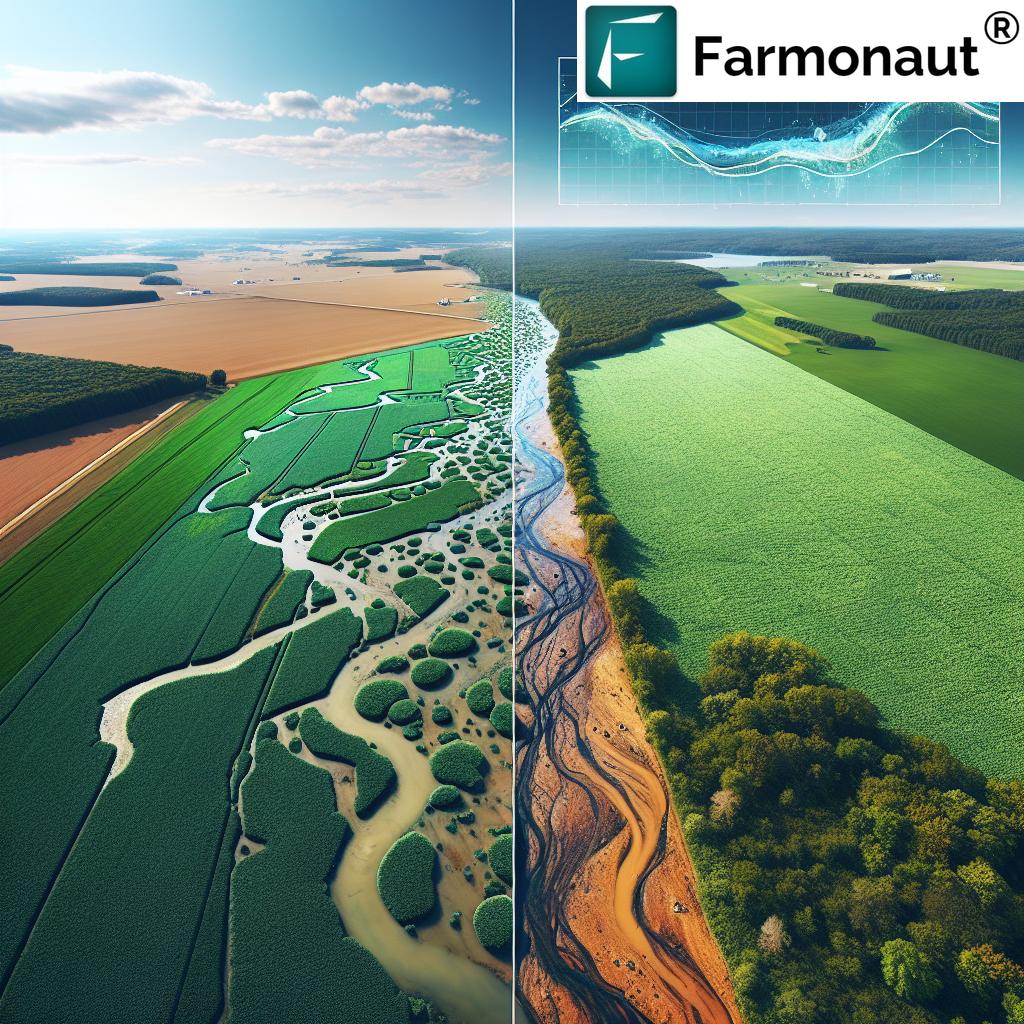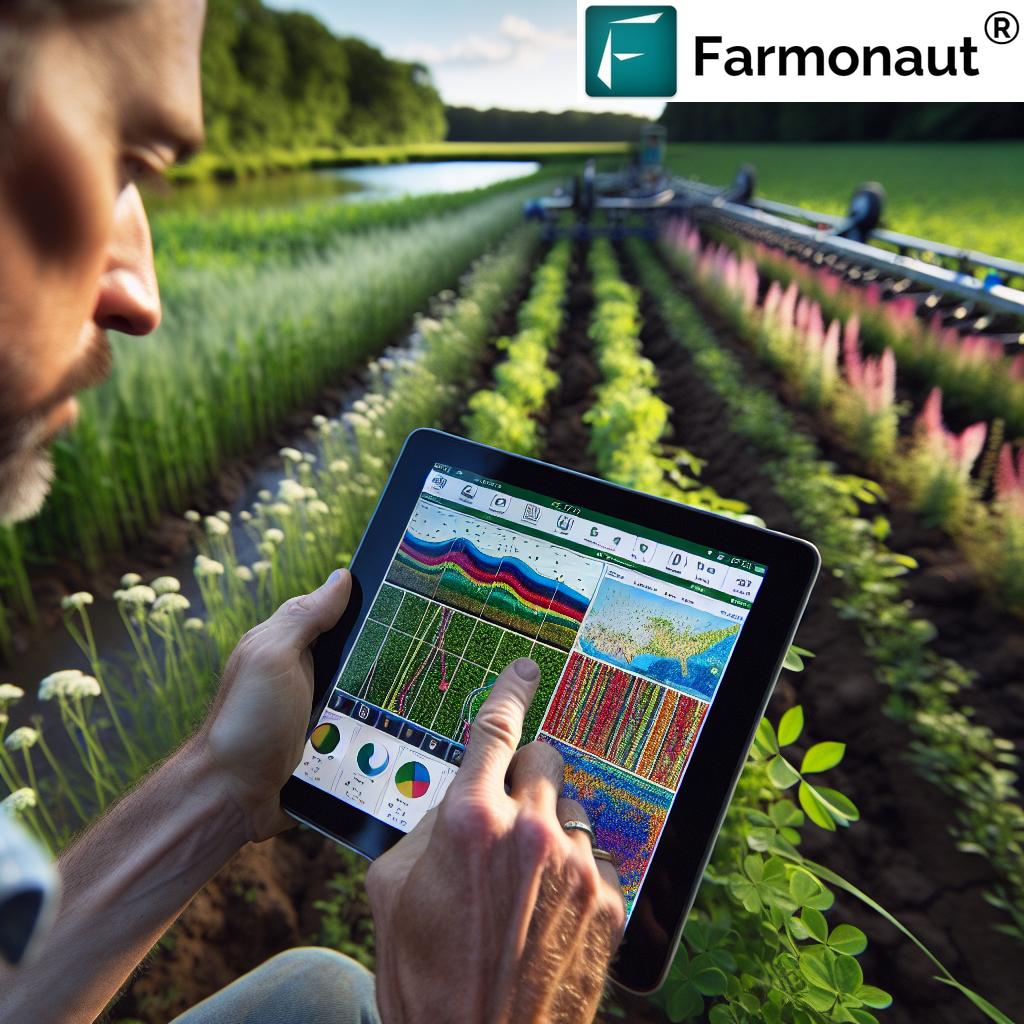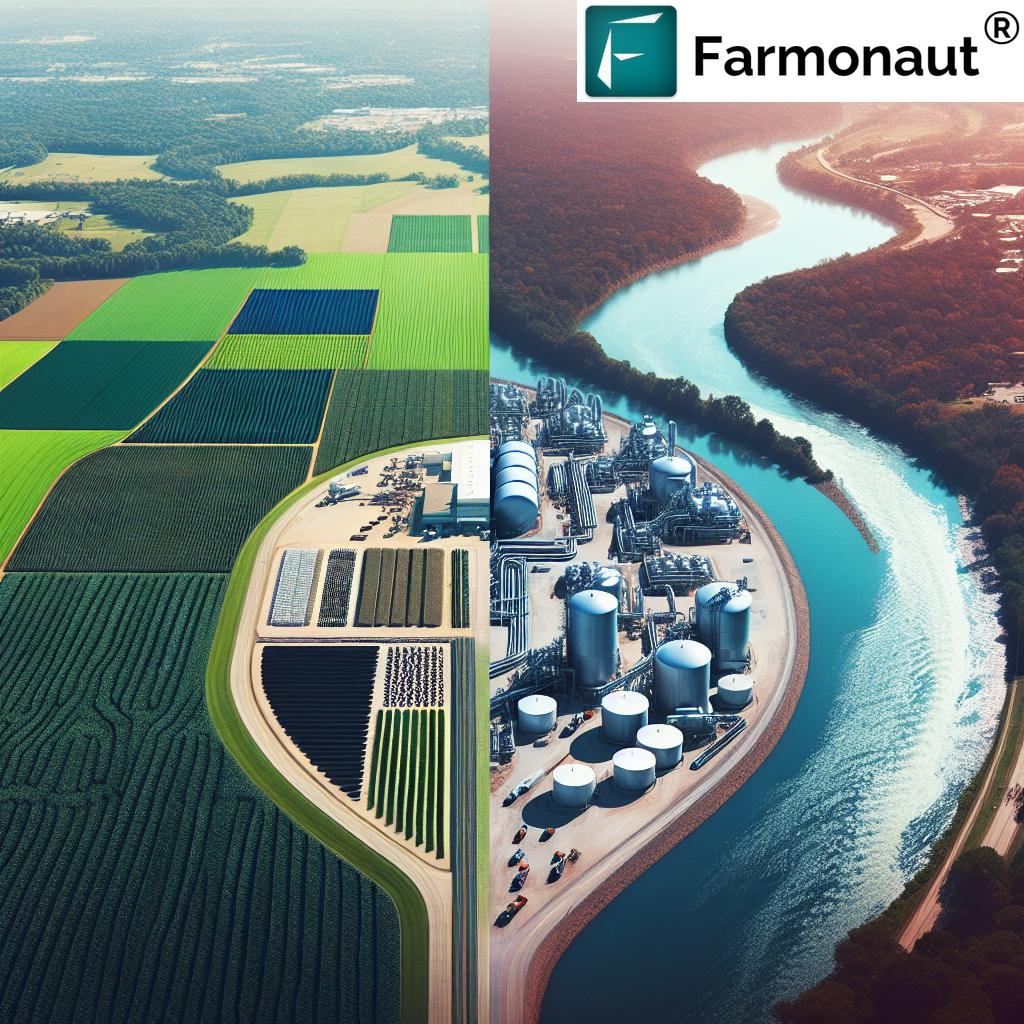Revolutionizing Chesapeake Bay Conservation: How Cover Crops and GIS Transform Sustainable Agriculture in Maryland
“Cover crops in Maryland’s Chesapeake Bay watershed can capture up to 40% of excess nitrogen, reducing agricultural runoff significantly.”

Welcome to our comprehensive exploration of how sustainable agriculture practices and cover crop benefits are revolutionizing soil health management and water quality improvement in the Chesapeake Bay watershed. As we delve into this crucial topic, we’ll uncover the transformative power of cover crops in mitigating nutrient pollution and controlling agricultural runoff. Join us on this journey to discover cutting-edge research, innovative techniques, and the multifaceted advantages of cover crops in preserving one of America’s most precious ecosystems.
The Chesapeake Bay: A Delicate Ecosystem Under Threat
The Chesapeake Bay, the largest estuary in the United States, is a vital ecological and economic resource. Spanning over 64,000 square miles across six states, including Maryland, this complex watershed is home to diverse wildlife and supports numerous industries. However, the bay faces significant challenges, primarily due to nutrient pollution and sediment runoff from agricultural activities.
Agricultural practices, while essential for food production, have historically contributed to the degradation of water quality in the Chesapeake Bay. Excess nutrients, particularly nitrogen and phosphorus, from fertilizers and animal waste, along with soil erosion, have led to algal blooms, oxygen-depleted dead zones, and habitat destruction. These issues not only threaten the bay’s aquatic life but also impact the livelihoods of those dependent on its resources.
Enter Cover Crops: Nature’s Solution to Agricultural Runoff
In recent years, a powerful ally has emerged in the fight to protect the Chesapeake Bay: cover crops. These non-cash crops, planted during off-seasons or between regular crop rotations, offer a natural and effective method to combat many of the environmental challenges posed by traditional farming practices.
- Soil Protection: Cover crops shield the soil from erosion caused by wind and rain, reducing sediment runoff into waterways.
- Nutrient Capture: They act as living filters, absorbing excess nutrients that would otherwise leach into groundwater or run off into streams.
- Soil Health Enhancement: Cover crops improve soil structure, increase organic matter content, and promote beneficial microbial activity.
- Weed Suppression: By outcompeting weeds, cover crops reduce the need for herbicides, further protecting water quality.
As we explore the transformative potential of cover crops, it’s crucial to understand how modern technology, particularly Geographic Information Systems (GIS), plays a pivotal role in maximizing their effectiveness. Farmonaut, a leading agricultural technology company, offers advanced satellite-based farm management solutions that complement cover crop strategies, enhancing precision farming techniques and ecosystem restoration efforts in agriculture.
The Science Behind Cover Crop Effectiveness
Recent research conducted by graduate students and agricultural scientists in Maryland has shed light on the optimal planting times and techniques for maximizing the benefits of cover crops. These studies have revealed fascinating insights into how different cover crop species interact with soil dynamics and nutrient cycles.
Key Findings:
- Early planting of winter cover crops, such as rye, significantly increases nitrogen capture potential.
- Diverse cover crop mixes can provide a broader range of ecosystem services compared to single-species plantings.
- The timing of cover crop termination in spring can influence nutrient release patterns for subsequent cash crops.
These scientific discoveries are crucial for developing effective cover crop strategies that balance the needs of farmers with environmental conservation goals.
Innovative Techniques in Cover Crop Implementation
Farmers and researchers in Maryland are pioneering innovative techniques to enhance the effectiveness of cover crops:
- Aerial Seeding: This method allows for the establishment of cover crops before the harvest of cash crops, extending the growing season and maximizing nutrient capture.
- Precision Planting: Using GPS-guided equipment, farmers can precisely plant cover crops in patterns that optimize their growth and effectiveness.
- Roller-Crimper Technology: This technique allows for the termination of cover crops without herbicides, creating a natural mulch layer that suppresses weeds and conserves soil moisture.
These advanced practices, combined with the power of GIS and satellite imaging provided by platforms like Farmonaut, enable farmers to make data-driven decisions about cover crop management. By leveraging these technologies, farmers can optimize their cover crop strategies for maximum environmental benefit while maintaining productive agricultural operations.
Explore Farmonaut’s API for advanced agricultural insights
The Multifaceted Benefits of Cover Crops
The advantages of incorporating cover crops into agricultural systems extend far beyond simple erosion control. Let’s delve deeper into the comprehensive benefits these unsung heroes provide:
- Soil Conservation: Cover crops create a protective canopy over the soil, shielding it from the erosive forces of wind and rain. Their root systems help bind soil particles together, preventing valuable topsoil from being washed away into waterways.
- Nutrient Recycling: As cover crops grow, they absorb excess nutrients from the soil, particularly nitrogen and phosphorus. When these crops are terminated, they release these nutrients back into the soil slowly, providing a natural fertilizer for the next cash crop.
- Weed Suppression: By outcompeting weeds for resources like sunlight, water, and nutrients, cover crops naturally reduce weed pressure. This can significantly decrease the need for herbicides, contributing to cleaner waterways and healthier ecosystems.
- Improved Soil Structure: The roots of cover crops penetrate the soil, creating channels for water infiltration and aeration. This improves soil structure, reducing compaction and enhancing the soil’s capacity to retain water and nutrients.
- Enhanced Biodiversity: Cover crops provide habitat and food sources for beneficial insects, birds, and soil microorganisms. This increased biodiversity contributes to natural pest control and overall ecosystem health.
- Carbon Sequestration: As cover crops grow, they capture carbon dioxide from the atmosphere and store it in their biomass and the soil. This process not only mitigates climate change but also improves soil organic matter content.
These multifaceted benefits create a positive feedback loop, where improved soil health leads to better water quality, which in turn supports healthier ecosystems both on land and in the Chesapeake Bay.

“Over 500,000 acres in Maryland utilize cover crops annually, contributing to a 20% reduction in bay nutrient pollution.”
Balancing Act: Cover Crops and Cash Crop Production
While the environmental benefits of cover crops are clear, farmers face the challenge of integrating them into their existing crop rotation strategies. Balancing the timing of cover crop planting and termination with the needs of cash crops requires careful planning and management.
Key Considerations for Farmers:
- Selecting cover crop species that complement the nutrient needs of subsequent cash crops
- Timing cover crop termination to avoid competition with cash crop planting
- Managing cover crop residue to facilitate smooth planting operations
- Adjusting fertilizer applications to account for nutrients provided by cover crops
Advanced farming technologies, such as those offered by Farmonaut, can assist farmers in making these complex decisions. By providing real-time satellite imagery and data analytics, Farmonaut enables farmers to monitor crop health, soil moisture levels, and other critical metrics. This information helps in optimizing both cover crop and cash crop management strategies.
Check out Farmonaut’s API Developer Docs for integration possibilities
GIS Applications in Cover Crop Management
Geographic Information Systems (GIS) have revolutionized the way we approach cover crop management and conservation efforts in the Chesapeake Bay watershed. These powerful tools allow for precise mapping, analysis, and decision-making processes that enhance the effectiveness of cover crop programs.
Key GIS Applications in Cover Crop Management:
- Spatial Analysis: GIS helps identify areas within a farm or watershed that are most susceptible to erosion or nutrient loss, allowing for targeted cover crop implementation.
- Yield Mapping: By overlaying cover crop data with cash crop yield maps, farmers can assess the impact of cover crops on productivity and make informed decisions about future plantings.
- Water Quality Monitoring: GIS facilitates the tracking of water quality improvements in relation to cover crop adoption across the watershed, providing valuable data for policy-makers and conservationists.
- Precision Agriculture: Integration of GIS with precision farming techniques allows for variable-rate seeding and fertilizer application, optimizing resource use and environmental benefits.
Farmonaut’s platform leverages these GIS capabilities, offering farmers and researchers powerful tools for monitoring and managing cover crops. By combining satellite imagery with advanced analytics, Farmonaut provides actionable insights that drive sustainable agricultural practices.
Community-Driven Initiatives and Incentives
The success of cover crop programs in the Chesapeake Bay watershed is largely due to strong community support and innovative incentive structures. Maryland, in particular, has been at the forefront of encouraging farmers to adopt these environmentally friendly practices.
Key Initiatives:
- Cover Crop Cost-Share Programs: State and federal agencies offer financial assistance to farmers for implementing cover crops, offsetting initial costs and encouraging widespread adoption.
- Education and Outreach: Extension services and agricultural organizations provide workshops, field days, and training sessions to help farmers understand and implement effective cover crop strategies.
- Tax Incentives: Some jurisdictions offer property tax credits for farmers who implement cover crops and other conservation practices.
- Carbon Market Opportunities: Emerging carbon credit markets present potential additional revenue streams for farmers who sequester carbon through cover crop use.
These community-driven efforts, combined with the technological support provided by companies like Farmonaut, create a robust ecosystem of support for sustainable agriculture in the region.
The Future of Chesapeake Bay Conservation
As we look to the future, the role of cover crops in preserving the health of the Chesapeake Bay watershed is more critical than ever. Climate change presents new challenges, including more frequent extreme weather events and shifting growing seasons. Cover crops will play an increasingly important role in building resilience into agricultural systems and protecting water resources.
Emerging Trends and Opportunities:
- Advanced Cover Crop Breeding: Researchers are developing new cover crop varieties tailored to specific regional needs and climate conditions.
- Integration with Precision Agriculture: The combination of cover crops with precision farming techniques, supported by platforms like Farmonaut, will enable even more targeted and effective conservation efforts.
- Ecosystem Services Markets: The development of markets that compensate farmers for the environmental benefits provided by cover crops could further incentivize adoption.
- Policy Innovation: Continued refinement of policies and programs to support cover crop implementation will be crucial for long-term success.
By embracing these innovations and continuing to build on the strong foundation of community support and scientific research, we can ensure a healthier, more sustainable future for the Chesapeake Bay and the communities that depend on it.
Cover Crop Benefits in Chesapeake Bay Conservation
| Benefit Category | Specific Advantage | Environmental Impact | Potential Economic Value |
|---|---|---|---|
| Soil Health Improvement | Increases organic matter, enhances soil structure | High | $30-$50/acre/year in reduced fertilizer costs |
| Nutrient Management | Captures excess nitrogen, reduces leaching | High | $15-$25/acre/year in nutrient retention |
| Erosion Control | Reduces soil loss, protects topsoil | High | $20-$40/acre/year in soil conservation |
| Water Quality Enhancement | Filters runoff, reduces sediment in waterways | High | Indirect savings on water treatment costs |
| Carbon Sequestration | Captures atmospheric CO2, builds soil carbon | Medium | Potential for carbon credit earnings ($10-$20/acre/year) |
Conclusion: A Sustainable Path Forward
The integration of cover crops and advanced GIS technologies in Maryland’s agricultural practices represents a significant step towards sustainable farming and the restoration of the Chesapeake Bay ecosystem. By embracing these innovative approaches, farmers are not only protecting vital water resources but also enhancing the long-term productivity and resilience of their lands.
As we’ve explored throughout this blog, the benefits of cover crops extend far beyond simple erosion control. They play a crucial role in nutrient management, soil health improvement, biodiversity enhancement, and even climate change mitigation. The support of community-driven initiatives, coupled with technological advancements provided by companies like Farmonaut, creates a powerful framework for continued progress in agricultural sustainability.
Looking ahead, the future of Chesapeake Bay conservation is bright. With ongoing research, policy support, and farmer engagement, we can expect to see even greater adoption of cover crops and other sustainable practices. This collective effort will not only preserve the ecological integrity of the Chesapeake Bay but also ensure the prosperity of the agricultural communities that call this region home.
As we continue to face environmental challenges, the lessons learned from the Chesapeake Bay watershed serve as a model for sustainable agriculture worldwide. By working in harmony with natural systems and leveraging cutting-edge technology, we can create a future where productive farming and environmental conservation go hand in hand.
FAQ Section
Q: What are cover crops, and why are they important for the Chesapeake Bay?
A: Cover crops are non-cash crops planted during off-seasons or between regular crop rotations. They are crucial for the Chesapeake Bay because they reduce soil erosion, capture excess nutrients, improve water quality, and enhance overall soil health, thereby protecting the bay’s delicate ecosystem.
Q: How do cover crops help in reducing nutrient pollution?
A: Cover crops absorb excess nutrients, particularly nitrogen and phosphorus, from the soil. This prevents these nutrients from leaching into groundwater or running off into streams and eventually the Chesapeake Bay, where they can cause harmful algal blooms and oxygen-depleted dead zones.
Q: What role does GIS play in cover crop management?
A: Geographic Information Systems (GIS) enable precise mapping, analysis, and decision-making in cover crop management. It helps in identifying erosion-prone areas, monitoring water quality improvements, and integrating with precision agriculture techniques for optimized resource use.
Q: Are there financial incentives for farmers to implement cover crops?
A: Yes, many states, including Maryland, offer cost-share programs, tax incentives, and other financial assistance to encourage farmers to adopt cover crops. Additionally, emerging carbon markets may provide opportunities for farmers to earn credits for carbon sequestration through cover crop use.
Q: How can technology like Farmonaut’s platform assist in cover crop management?
A: Farmonaut’s platform utilizes satellite imagery and advanced analytics to provide real-time insights on crop health, soil moisture, and other critical metrics. This information helps farmers optimize their cover crop strategies, enhancing both environmental benefits and agricultural productivity.




















